Is it true that without shooting there’d be no pheasants here?
The short answer is, that’s probably true, yes.
Pheasants are absolutely beautiful birds, so does that mean we should be grateful to shooting for ensuring there are pheasants for us to look at?
Not at all. And that’s because we really ought to look at things from the pheasant’s point of view.
The pheasant we all know and see (the Ring-necked or Common Pheasant) is actually a Eurasian species, originally found from the Balkans and the Black and Caspian Seas eastwards to Manchuria, Siberia, Korea, and Japan.
The species is only here in the UK now because it is reared and released in huge numbers to be shot.
Every year the shooting industry (shooting estates and shooting syndicates) release about 40 MILLION pheasants into the countryside, just so shooters can kill them for ‘sport’. (There are now small populations in (especially) England and lowland Scotland, but these are small in comparison to the releases and impossible to quantify separately).
Many pheasants start life in intensive breeding facilities in Europe and are packed into crates when chicks to be reared in outdoor pens here in the UK.

As our own undercover investigations have shown (for example through undercover footage taken at Lancashire’s Leighton Hall), the conditions that some of the birds are reared in here are disgusting and heart-breaking.
According to industry research a quarter die before shooting even starts.
Many more are run over. 2017 research from Cardiff University and Exeter University found that pheasants are 13 times more likely to die on roads than other birds, and that almost 7% of all roadkill on Britain’s roads involve pheasants.
- That roadkill often provides food for foxes and crows – the very same animals that gamekeepers are employed to relentlessly target and kill because they say they’re ‘too common’.
In 2020 Defra (the government department responsible for the environment) added the Common Pheasant to Schedule 9 of the Wildlife and Countryside Act, which contains species which cause ecological, environmental or socio-economic harm.
